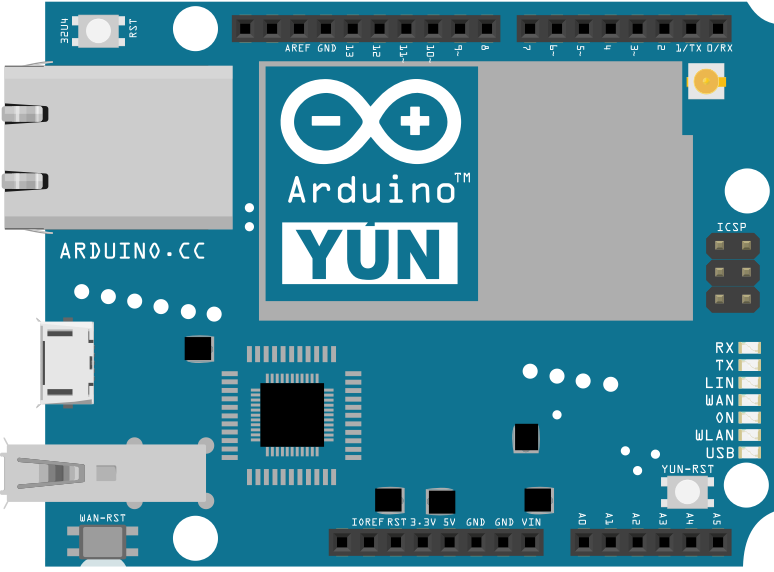码丁实验室,一站式儿童编程学习产品,寻地方代理合作共赢,微信联系:leon121393608。
Yún Serial Terminal(yun串口终端)
- 这个例子可以让你使用YúN的32u4处理器或连接到shield的微型控制器(作为Linux处理器的串口终端)。
- 通过USB(不是在WiFi上)上传这个到一个Yún设备,然后打开串口监视器(波特率为115200bps)来看到Linux处理器的启动过程。你也可以用这个程序把串行监视器作为一个基本的linux命令行界面。
- 从串行监视器可以发出以下命令:
'~' 后跟着 '0' -> 设置 UART 速率为 57600 波特率
'~' 后跟着 '1' -> 设置 UART 速率为 115200 波特率
'~' 后跟着 '2' -> 设置 UART 速率为 250000 波特率
'~' 后跟着 '3' -> 设置 UART 速率为 500000 波特率
'~' 后跟着 '~' -> 发送bridge的关机命令控制控制台
硬件要求
- Yún 开发板或者 shield
电路
这个例子不需要额外的连线
图由 Fritzing 软件绘制
样例代码
- 创建一个变量来保存和处理器通信的波特率,和一个用来确定是否进入命令模式的变量。
long linuxBaud = 250000;
boolean commandMode = false;
[Get Code]
- 在 setup()里打开连接到计算机的串口和Linux
void setup() {
Serial.begin(115200);
Serial1.begin(linuxBaud);
}
[Get Code]
- 在loop()里,从一个串口连接复制数据到其他串口。如果有”~”字符通过,进入命令模式。
void loop() {
// copy from virtual serial line to uart and vice versa
if (Serial.available()) { // got anything from USB-Serial?
char c = (char)Serial.read(); // read from USB-serial
if (commandMode == false) { // if we aren't in command mode...
if (c == '~') { // Tilde '~' key pressed?
commandMode = true; // enter in command mode
} else {
Serial1.write(c); // otherwise write char to Linux
}
} else { // if we are in command mode...
if (c == '0') { // '0' key pressed?
Serial1.begin(57600); // set speed to 57600
Serial.println("Speed set to 57600");
} else if (c == '1') { // '1' key pressed?
Serial1.begin(115200); // set speed to 115200
Serial.println("Speed set to 115200");
} else if (c == '2') { // '2' key pressed?
Serial1.begin(250000); // set speed to 250000
Serial.println("Speed set to 250000");
} else if (c == '3') { // '3' key pressed?
Serial1.begin(500000); // set speed to 500000
Serial.println("Speed set to 500000");
} else if (c == '~') {
Serial1.write((uint8_t *)"xffx05XXXXXx0dxaf", 11);
Serial.println("Sending bridge's shutdown command");
} else { // any other key pressed?
Serial1.write('~'); // write '~' to Linux
Serial1.write(c); // write char to Linux
}
commandMode = false; // in all cases exit from command mode
}
}
if (Serial1.available()) { // got anything from Linux?
char c = (char)Serial1.read(); // read from Linux
Serial.write(c); // write to USB-serial
}
}
[Get Code]
- 完整代码如下:
/*
Arduino Yún USB-to-Serial
Allows you to use the Yún101/YunShield/Yún processor as a
serial terminal for the Linux side on the Yún.
Upload this to a Yún101/YunShield/Yún via serial (not WiFi) then open
the serial monitor at 115200 to see the boot process of Linux.
You can also use the serial monitor as a basic command line
interface for Linux using this sketch.
From the serial monitor the following commands can be issued:
'~' followed by '0' -> Set the UART speed to 57600 baud
'~' followed by '1' -> Set the UART speed to 115200 baud
'~' followed by '2' -> Set the UART speed to 250000 baud
'~' followed by '3' -> Set the UART speed to 500000 baud
'~' followed by '~' -> Sends the bridge's shutdown command to
obtain the console.
The circuit:
Yún101/YunShield/Yún
created March 2013
by Massimo Banzi
modified by Cristian Maglie
This example code is in the public domain.
http://www.arduino.cc/en/Tutorial/YunSerialTerminal
*/
long linuxBaud = 250000;
void setup() {
SERIAL_PORT_USBVIRTUAL.begin(115200); // open serial connection via USB-Serial
SERIAL_PORT_HARDWARE.begin(linuxBaud); // open serial connection to Linux
}
boolean commandMode = false;
void loop() {
// copy from USB-CDC to UART
int c = SERIAL_PORT_USBVIRTUAL.read(); // read from USB-CDC
if (c != -1) { // got anything?
if (commandMode == false) { // if we aren't in command mode...
if (c == '~') { // Tilde '~' key pressed?
commandMode = true; // enter in command mode
} else {
SERIAL_PORT_HARDWARE.write(c); // otherwise write char to UART
}
} else { // if we are in command mode...
if (c == '0') { // '0' key pressed?
SERIAL_PORT_HARDWARE.begin(57600); // set speed to 57600
SERIAL_PORT_USBVIRTUAL.println("Speed set to 57600");
} else if (c == '1') { // '1' key pressed?
SERIAL_PORT_HARDWARE.begin(115200); // set speed to 115200
SERIAL_PORT_USBVIRTUAL.println("Speed set to 115200");
} else if (c == '2') { // '2' key pressed?
SERIAL_PORT_HARDWARE.begin(250000); // set speed to 250000
SERIAL_PORT_USBVIRTUAL.println("Speed set to 250000");
} else if (c == '3') { // '3' key pressed?
SERIAL_PORT_HARDWARE.begin(500000); // set speed to 500000
SERIAL_PORT_USBVIRTUAL.println("Speed set to 500000");
} else if (c == '~') { // '~` key pressed?
SERIAL_PORT_HARDWARE.write((uint8_t *)"xffx05XXXXXx7fxf9", 11); // send "bridge shutdown" command
SERIAL_PORT_USBVIRTUAL.println("Sending bridge's shutdown command");
} else { // any other key pressed?
SERIAL_PORT_HARDWARE.write('~'); // write '~' to UART
SERIAL_PORT_HARDWARE.write(c); // write char to UART
}
commandMode = false; // in all cases exit from command mode
}
}
// copy from UART to USB-CDC
c = SERIAL_PORT_HARDWARE.read(); // read from UART
if (c != -1) { // got anything?
SERIAL_PORT_USBVIRTUAL.write(c); // write to USB-CDC
}
}
[Get Code]
更多
- Bridge: 从网页浏览器进入开发板的引脚。
- Console ASCII Table: 示范了怎样打印多种格式到控制台。
- Console Pixel: 通过控制台控制一个LED灯。
- Console Read: 从控制台那里分析信息,然后重复发送返回。
- Datalogger: 在SD卡上保存传感器信息。
- File Write Script: 示范怎样在Process上写入和执行外壳脚本。
- HTTP Client: 建造一个简单的客户端,可以下载网页并且打印到串口监视器。
- HTTP Client Console: 建造一个简单的客户端,可以下载网页并且用控制台通过WIFI打印到串口监视器。
- Mailbox Read Messages: 用REST API通过一个网页发送文本信息到。
- Process: 示范怎么用Process运行 Linux 命令。
- Remote Due Blink: 示范怎么远程上传程序到DUE开发板上。
- Shell Commands: 用Process 来运行 shell 命令。
- SpacebrewYun: 在Arduino IDE软件的例子上看更多关于 Spacebrew 文档信息。
- Temboo: 在Arduino IDE软件的例子上看更多关于 Temboo 文档信息。
- Temperature Web Panel: 当浏览者要求时,粘贴传感数据到网页上。
- Time Check: 从网络的时间服务器获得时间,并且打印到串口监视器。
- WiFi Status: 运行一个预配置的脚本,报告返回当前wifi网络的强度。
- Yun First Config: 用串口监视器不费力地连接你的云产品到wifi网络,并且在上面回答一些简单的问题。
- Yun Serial Terminal: 通过串口监视器进入Linux终端。


